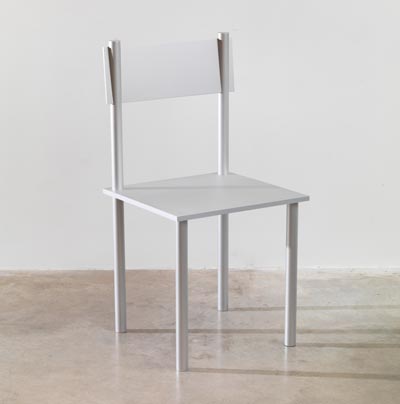|
|
||
|
The British designer froze metal to –346 degrees while living in a Liverpool factory to produce a collection of tactile, weighty furniture, on display in an exhibition in New York. Caia Hagel went to the show’s opening The design and art elite of New York City gathered at Friedman Benda Gallery in Chelsea last week to be the first to see Paul Cocksedge’s Freeze, an exhibition showcasing the British design star’s long-awaited project and second solo show in the US, a ground-breaking investigation where metals meet extreme cold to create objects of beauty. Three colossal 2m-in-diameter round tables and two shiny benches, a lustrous desk, a glowy lamp, a metal bookshelf and a jointless mini chair are the results of the Freeze experiment, an effort that took five years and a live-in stint at a Liverpool factory to complete. What began as some fun in the snow by the designer, where he tested how cold affected metal, resulted in a very deep study on how to harness nature to invent furniture that’s never been made before – a collaboration with the Friedman Benda Gallery that brought this creative dream to life.
“I always think in the back of my mind about how a person is involved in the work I do,” Cocksedge told me as the show was about to open, “How to get closer to a person (here he cited his well-loved KISS installation for the city of Milan and the electronic products he creates that amplify the experience of sound and dance as examples of very outright and ambitious acts of fostering togetherness through design). With Freeze, it’s a departure. It’s not about how the pieces will work in people’s houses, it’s about creative freedom.” This project involved a lot of people, time and dedication. “We had to work with a company in Liverpool – we were living there for nearly a year, it involved the entire factory. These furniture pieces cannot exist without the human labour and friendships that were part of the process. You can’t even move one of these pieces without a collaboration, they weigh hundreds of kilos,” Cocksedge said, smiling. This old-fashioned approach was a conscious political act. “There’s a popular futurist trend embracing robotics that’s all about removing people from the process of making things,” he continued, “Freeze is about wanting to touch things and wanting to celebrate each other and our materials with wonder and imagination.” As the non-human element in this party, metals have been very much celebrated in the hands of Cocksedge – almost in a way that recalls the insignia in antique Stradivarius violins: “In life I was silent; in death I sing.” If metals are ever dead or alive, they certainly sing under Cocksedge’s tutelage, as they’re bent into sculptural form using gravity and temperature.
By the process of cooling aluminum, copper and variations of steel to – 346°F using liquid nitrogen, the furniture was made first by being shrunk by 2000th of a millimetre. When frozen, the steel was cut into with holes and slots and planes of copper, carbon steel, brass and aluminum were introduced that when warmed, expanded and locked to create joints that are very strong and that allow many varieties of metals to fuse that are normally never co-existent without welding – with invisible joints. This gives them a unique aesthetic. They’re also beautiful and colourful and yet scientific. “They feel familiar but mysterious,” one guest beamed, and in response to their sheer mass, “They’re in charge!” said another. The complex Freeze ensemble make a weighty presence. They have the contemporary largesse and mirror-like surfaces of a Jeff Koons. But as humble, old-world studies in minerals and the simplicity of “snow power”, they feel a little more like superheroes born of a saga that might be called “nature goes to Hollywood”. I half expected to see pink-haired teens taking selfies with them on opening night. Instead, the crowds were sitting in them, drawing their hands across them, leaning into them deep in conversations, sensually engaged with each other in the furniture’s powerful, inviting aura. |
Words
Paul Cocksedge: Freeze
Images: Mark Cocksedge; courtesy of Friedman Benda and Paul Cocksedge Studio |
|
|
||
|
|
||























